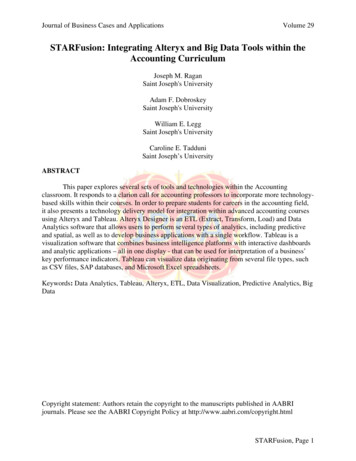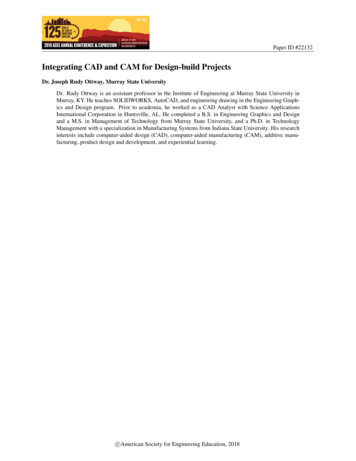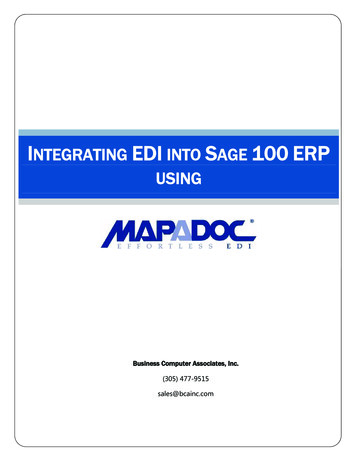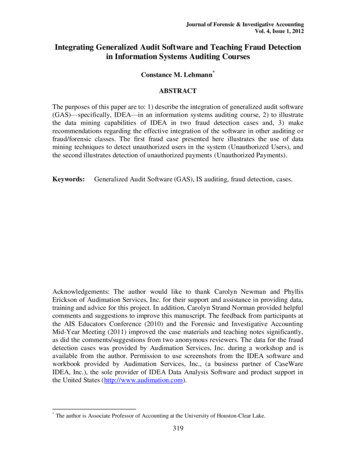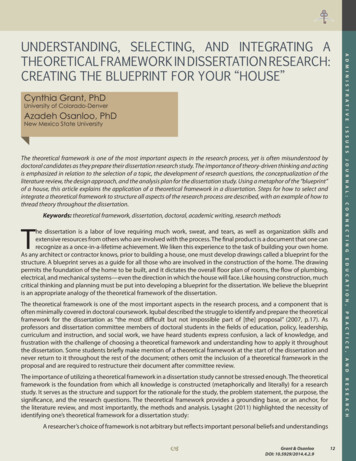
Transcription
Cynthia Grant, PhDUniversity of Colorado-DenverAzadeh Osanloo, PhDI S S U E SNew Mexico State UniversityA D M I N I S T R A T I V EUNDERSTANDING, SELECTING, AND INTEGRATING ATHEORETICAL FRAMEWORK IN DISSERTATION RESEARCH:CREATING THE BLUEPRINT FOR YOUR “HOUSE”J O U R N A L :The theoretical framework is one of the most important aspects in the research process, yet is often misunderstood bydoctoral candidates as they prepare their dissertation research study. The importance of theory-driven thinking and actingis emphasized in relation to the selection of a topic, the development of research questions, the conceptualization of theliterature review, the design approach, and the analysis plan for the dissertation study. Using a metaphor of the “blueprint”of a house, this article explains the application of a theoretical framework in a dissertation. Steps for how to select andintegrate a theoretical framework to structure all aspects of the research process are described, with an example of how tothread theory throughout the dissertation.C O N N E C T I N GKeywords: theoretical framework, dissertation, doctoral, academic writing, research methodsTE D U C A T I O N ,he dissertation is a labor of love requiring much work, sweat, and tears, as well as organization skills andextensive resources from others who are involved with the process. The final product is a document that one canrecognize as a once-in-a-lifetime achievement. We liken this experience to the task of building your own home.As any architect or contractor knows, prior to building a house, one must develop drawings called a blueprint for thestructure. A blueprint serves as a guide for all those who are involved in the construction of the home. The drawingpermits the foundation of the home to be built, and it dictates the overall floor plan of rooms, the flow of plumbing,electrical, and mechanical systems—even the direction in which the house will face. Like housing construction, muchcritical thinking and planning must be put into developing a blueprint for the dissertation. We believe the blueprintis an appropriate analogy of the theoretical framework of the dissertation.P R A C T I C E ,The theoretical framework is one of the most important aspects in the research process, and a component that isoften minimally covered in doctoral coursework. Iqubal described the struggle to identify and prepare the theoreticalframework for the dissertation as “the most difficult but not impossible part of [the] proposal” (2007, p.17). Asprofessors and dissertation committee members of doctoral students in the fields of education, policy, leadership,curriculum and instruction, and social work, we have heard students express confusion, a lack of knowledge, andfrustration with the challenge of choosing a theoretical framework and understanding how to apply it throughoutthe dissertation. Some students briefly make mention of a theoretical framework at the start of the dissertation andnever return to it throughout the rest of the document; others omit the inclusion of a theoretical framework in theproposal and are required to restructure their document after committee review.A N DR E S E A R C HThe importance of utilizing a theoretical framework in a dissertation study cannot be stressed enough. The theoreticalframework is the foundation from which all knowledge is constructed (metaphorically and literally) for a researchstudy. It serves as the structure and support for the rationale for the study, the problem statement, the purpose, thesignificance, and the research questions. The theoretical framework provides a grounding base, or an anchor, forthe literature review, and most importantly, the methods and analysis. Lysaght (2011) highlighted the necessity ofidentifying one’s theoretical framework for a dissertation study:A researcher’s choice of framework is not arbitrary but reflects important personal beliefs and understandingsaGrant & OsanlooDOI: 10.5929/2014.4.2.912
VOLUME 4, ISSUE 2R E S E A R C Habout the nature of knowledge, how it exists (in the metaphysical sense) in relation to the observer, and thepossible roles to be adopted, and tools to be employed consequently, by the researcher in his/her work. (p.572)Without a theoretical framework, the structure and vision for a study is unclear, much like a house that cannotbe constructed without a blueprint. By contrast, a research plan that contains a theoretical framework allows thedissertation study to be strong and structured with an organized flow from one chapter to the next.P R A C T I C E ,A N DOver the past 30 years, there has been an increasing trend to include a theoretical framework in the dissertation(Melendez, 2002). There is an expectation by most chairpersons and committee members that a dissertation studywill be informed by theory. Despite these realities, oftentimes students begin the dissertation process at a loss forhow to accomplish working with a theoretical framework. Concurrently, incorporating a theoretical framework intoresearch studies is a task that some may continue to struggle with post-graduation. Silver and Herbst (as cited inLester, 2005) have acknowledged that journal submissions are often rejected for being atheoretical, or having notheory. This underscores the importance of teaching students how to implement a theoretical framework in theirresearch, as it pertains not only to the dissertation, but also to scholarship and research activities in the professorate.C O N N E C T I N GE D U C T A T I O N ,Thus, the purpose of this article is to provide an overview of the theoretical framework and to outline a blueprint forhow to understand, select, and integrate a theoretical framework into one’s research when writing the dissertation.We offer the analogy of using a blueprint when building a house to provide the reader with a visual representation ofthe importance of this step in the development of a dissertation idea. We hope the necessity of this step in preparingthe dissertation will be metaphorically obvious—a contractor could not possibly know what kind of house to buildwithout instructions mapped out ahead of time. Similarly, one cannot guide a reader through thinking about adissertation study without a clear explication of the study’s theoretical framework. This article is intended to be aresource for faculty working with doctoral students in the classroom or in an advisory role; however, it is primarilyaimed towards doctoral candidates who are seeking guidance with this foundational piece of the dissertation.This article first covers the basics of understanding a theoretical framework, while simultaneously introducing theanalogy of the blueprint for a house, which is a running theme throughout the entire article. This section also focuseson the differences between a theoretical and conceptual framework. Next, the article describes the important tenetsof selecting an appropriate theoretical framework for one’s research. Finally, we highlight strategies and techniquesfor implementing a theoretical framework in a dissertation study.J O U R N A L :UNDERSTANDING THE THEORETICAL FRAMEWORKWhat is a Theoretical Framework?A D M I N I S T R A T I V EI S S U E SThe theoretical framework is the “blueprint” for the entire dissertation inquiry. It serves as the guide on which to buildand support your study, and also provides the structure to define how you will philosophically, epistemologically,methodologically, and analytically approach the dissertation as a whole. Eisenhart defined a theoretical frameworkas “a structure that guides research by relying on a formal theory constructed by using an established, coherentexplanation of certain phenomena and relationships” (1991, p. 205). Thus, the theoretical framework consists of theselected theory (or theories) that undergirds your thinking with regards to how you understand and plan to researchyour topic, as well as the concepts and definitions from that theory that are relevant to your topic. Lovitts (2005)empirically defines criteria for applying or developing theory to the dissertation that must be appropriate, logicallyinterpreted, well understood, and align with the question at hand.We assert that students must select and clarify a theoretical framework from the time the dissertation topic is initiallyconceptualized. Philosophers such as Dooyeweerd (as cited in Sire, 2004, p. 35) have even gone so far as to call for“pretheoretical commitments” by the researcher to specifically identify one’s “worldview of the heart rather than themind.” We profess that the researcher’s choice of theory must be clearly stated and explicitly mentioned early in thewriting of the dissertation.Mertens acknowledged that the theoretical framework “has implications for every decision made in the researchprocess” (1998, p. 3), which supports our belief that the theoretical framework for a study must be identified at the13Grant & OsanlooDOI: 10.5929/2014.4.2.9b
A D M I N I S T R A T I V Einception of dissertation work. We also believe that all research is theoretical. The importance of theory-driventhinking and acting should be emphasized in relation to the selection of a topic, development of research questions,focus of the literature review, the design approach, and analysis plan for the dissertation study. Anderson, Day, andMcLaughlin (2006) capture the necessity of including a sound theoretical underpinning in a dissertation study with aquote from a dissertation supervisor who stated, “I don’t see how you can do a good piece of work that’s atheoretical”(p. 154). Similarly, Sarter (2005, p. 494) addressed the “limited usefulness of findings and conclusions” when a studyis not justified by a theoretical framework. Evidence across disciplines is clear that the explicit identification andinclusion of a theoretical framework is a necessity of sound research.The BlueprintI S S U E SWe liken the theoretical framework to the blueprint for a house—you (the student and researcher) are the architectwho is charged with choosing what you are going to build and how the property will be constructed as you imagineit. Once you create the blueprint, others will have a basic idea of what concepts and principles you will use to establishthe ideas and approaches to your dissertation. Only after a plan for the house has been determined can you begin tobuild the dissertation study.J O U R N A L :There are two types of blueprint drawings that are used in the construction industry that correlate to the theoreticalframework of the dissertation. First, an architect must create an elevation drawing to display the exterior of the home.This drawing offers an outside view of the style and structure, as shown in Figure 1.C O N N E C T I N GE D U C A T I O N ,P R A C T I C E ,Figure 1. Traditional style elevation blueprint drawingTypes of houses vary across the country, from a ranch, bungalow, an American Four Square, adobe style, Craftsman,split-level, etc. There is no one perfect or right style of house, although certain home styles dominate certain parts ofthe country. All can provide shelter and residency. Similarly, there is no one perfect or right theory for a dissertation,but certain theories are popular within each discipline. As an architect or construction developer must select the typeof house to build, the researcher must choose a theory to structure the dissertation.A N D R E S E A R C HTheories come from a multitude of sources in each discipline, and there are always more being created and appliedacross fields. For example, there is a plethora of options within the realm of educational leadership for selecting atheoretical framework. The researcher must select the appropriate theory of how his/her “house” will look on theexterior. The following list details a sampling of commonly used theories across disciplines.Transformational/relational theoriesTransactional/management theoriesServant leadership/moral theoriesTrait theoriesSituational theoriesaGrant & OsanlooDOI: 10.5929/2014.4.2.914
VOLUME 4, ISSUE 2E D U C T A T I O N ,P R A C T I C E ,A N DR E S E A R C H Behavioral theoriesSystems theoryDevelopmental theoryCognitive theorySense of community theoryBehavioral theoryQueer theoryFeminist TheoryCritical race theorySelf-efficacy theoryFunctionalist theoryRelational theoryMarxist TheoryIntersubjectivity theoryGender theoryChange theoryIdentity formationCommunity of InquiryTransformational theoryThe researcher’s choice of a theory provides structure to the entire dissertation. It provides a common world view orlens from which to support one’s thinking on the problem and analysis of data.A D M I N I S T R A T I V EI S S U E SJ O U R N A L :C O N N E C T I N GThe second type of blueprint is a floor plan, which details the interior details of the construction of a home. Thisdrawing allows the viewer to see the floor plan as if you were looking down from above into the home itself. All homescontain common elements such as rooms, doors, toilets, a kitchen, ventilation, electrical outlets, and an aestheticdesign. Yet how each home is organized or laid out will be in accordance with the design choice used in the elevationdrawing. For example, bungalow homes have similar floor plans and exteriors, but these floor plans are very differentthan an adobe home, as shown below in Figure 2.Figure 2. Craftsman style floor plan blueprint15Grant & OsanlooDOI: 10.5929/2014.4.2.9b
A D M I N I S T R A T I V ESimilarly, most professional practice dissertations and research articles follow the typical format of Statement of theProblem, Literature Review, Methods or Research Design, Presentation of the Data, and Discussion. Yet the contentsof each section or chapter will vary from student to student, and must be consistent with the theoretical frameworkselected for the dissertation as a whole.I S S U E SThe floor plan of the dissertation blueprint contains the theoretical principles, constructs, concepts, and tenantsof a theory. Specific conceptual elements of a theory (i.e. the interior of a home) must align with the researcher’stheoretical framework. Thus, you would not expect to walk into a bungalow style home and find massive stucco wallswith rounded edges, which are characteristic of an adobe style house. In reference to the dissertation blueprint, if youselect transformational leadership as your theoretical framework, each chapter should connect to theorists who havewritten about leadership and concepts drawn from this framework. It would not be appropriate to discuss variablesthat do not relate to principles of transformational leadership (e.g. gender, age, or ethnicity). This would be akin toplacing stucco, rounded walls in your Craftsman style home. Principles and constructs (the interior blueprint) thatdo not derive from your theoretical worldview of the study (the exterior blueprint) would be inconsistent and out ofplace.J O U R N A L :Before committing to a research design, you must first consider the guiding principles for your inquiry so that readerswill understand how you have situated the problem of study in relation to a theoretical context. The theory selected foryour study offers a conceptual basis for understanding, analyzing, and designing ways to investigate a problem. Thus,you need to know how you will define and approach your research problem and provide a rationale for how and whyyou are conducting your study in order for the reader to get a sense for where you stand on the problem itself. Thisbelief is supported by Maxwell, who wrote, “The function of this theory is to inform the rest of your design—to helpyou to assess and refine your goals, develop realistic and relevant research questions, select appropriate methods,and identify potential validity threats to your conclusions. It also helps you justify your research” (2004, pp. 33-34).C O N N E C T I N GEmbedded within the discussion of a theoretical framework is an explanation of a conceptual framework. While thesetwo ideas are similar in nature, they do differ in their approach, style, and utilization within a dissertation. This is animportant distinction for doctoral students to understand and grasp.The Difference Between a Theoretical and Conceptual FrameworkE D U C A T I O N ,Theoretical frameworks are sometimes referred to as a conceptual framework; however, these terms are neitherinterchangeable nor synonymous. They can be vague and lead to confusion for students and dissertation committeemembers alike. As such, it is important and necessary to differentiate these terms.P R A C T I C E ,We distinguish the two terms by clarifying that a theoretical framework is derived from an existing theory (or theories)in the literature that has already been tested and validated by others and is considered a generally acceptable theoryin the scholarly literature. As Merriam (2001) proposed, it is the researcher’s lens with which to view the world. It is theresponsibility of the doctoral student to make a unique application of the selected theory (or theories) so as to applytheoretical constructs to his or her dissertation study.A N DTraditionally, theoretical frameworks are developed a priori, or before data collection in quantitative designs.However, a theoretical framework may also involve a theory that is developed in the course of the dissertationstudy. Qualitative research designs may begin with a structured, or perhaps less structured theoretical framework tokeep the researcher from forcing preconceptions on the findings. In the latter case, the theoretical framework oftenemerges in the data analysis phase. Our dissertation committee work has focused almost exclusively on workingwith students who “borrow” blueprints from someone else’s theory and use those plans to build their own home. Forexample, one of our doctoral candidates used Burns (1978) transformational leadership theory to investigate howschool leaders implemented a change process in a K-12 environment. Principles and concepts of transformationalleadership were threaded throughout all chapters of the dissertation.R E S E A R C HWe believe this approach towards the utilization of theoretical frameworks can be used with qualitative, quantitative,and mixed method designs. However, we recognize that doctoral candidates are capable of crafting their ownblueprint for a new theory to be developed a posteriori as a result of their research endeavors.On the other hand, a conceptual framework, in our view, is the researcher’s understanding of how the researchaGrant & OsanlooDOI: 10.5929/2014.4.2.916
VOLUME 4, ISSUE 2R E S E A R C Hproblem will best be explored, the specific direction the research will have to take, and the relationship betweenthe different variables in the study. This is best summarized by Miles & Huberman (1994), who categorized it as asystem of concepts, assumptions, and beliefs that support and guide the research plan. Specifically, the conceptualframework “lays out the key factors, constructs, or variables, and presumes relationships among them” (1994, p. 440).Moreover, Camp (2001) aptly described a conceptual framework, asserting that a conceptual framework is a structureof what has been learned to best explain the natural progression of a phenomenon that is being studied.P R A C T I C E ,A N DThe conceptual framework offers a logical structure of connected concepts that help provide a picture or visualdisplay of how ideas in a study relate to one another within the theoretical framework. It is not simply a string ofconcepts, but a way to identify and construct for the reader your epistemological and ontological worldview andapproach to your topic of study. The conceptual framework also gives you an opportunity to specify and defineconcepts within the problem (Luse, Mennecke, & Townsend, 2012). Once the conceptual framework for a dissertationhas been established, you can then begin to determine how to go about writing your dissertation.E D U C T A T I O N ,In another example from our work supervising dissertations, one candidate relied on best practices in the researchliterature associated with interventions with special needs children. Relying on national policies and protocolsassociated with Response to Intervention (RtI), core principles of the Federal policy (screening, diagnosis, and progressmonitoring) were analyzed in relation to parent perceptions of service provisions for their children. Thus, RtI and bestpractices literature served as the conceptual framework for the study. However, the theoretical framework was thatof educational equity theory, as shown in Table 1.Table 1Distinction Between a Theoretical and Conceptual FrameworkC O N N E C T I N GTheoretical FrameworkConceptual FrameworkTheory: Educational Equity TheoryRtl Best PracticesCore concepts: screening, diagnosis,progress monitoring (as defined by NoChild Left Behind legislationJ O U R N A L :Theorists:Marx (1975)Brookover & Lezotte (1981)Key theoretical principles: equality,justified inequality, fair process, socialjustice access, participationI S S U E SReturning to our analogy of how writing a dissertation is similar to building a house, we believe that the theoreticalframework and its associated tenants and principles would entail the elevation blueprints for a house, whereas theconceptual framework would involve the floor plan blueprint of how information flows throughout the dissertation.Although these steps may be taken in tandem or one by one, we profess that the dissertation committee mustchallenge students to articulate both the conceptual and theoretical frameworks prior to beginning the dissertation.SELECTING AN APPROPRIATE THEORETICAL FRAMEWORKA D M I N I S T R A T I V ESelecting an appropriate theoretical framework for your dissertation research is an important and necessary processwith which all doctoral students should engage. The selection of a theoretical framework requires a deep andthoughtful understanding of your problem, purpose, significance, and research questions. It is imperative that allfour constructs—the problem, purpose, significance, and research questions—are tightly aligned and intricatelyinterwoven so that your theoretical framework can serve as the foundation for your work and guide your choice ofresearch design and data analysis.Think of the electrical system running through a house: your problem, purpose, significance, research questions,methodology, and data analysis plan must flow through all rooms in your house, connecting all the elements explicitlytogether to deliver power throughout the dissertation. All rooms of a house require electricity. Similarly, all aspects ofthe dissertation research should connect to the theoretical framework.17Grant & OsanlooDOI: 10.5929/2014.4.2.9b
A D M I N I S T R A T I V EFor the purpose of review and consistency, it is important to briefly discuss the essence of the problem, purpose, andsignificance of dissertation research.Brief Discussion of Problem, Purpose, and Significance in Dissertation ResearchProblem. This is one of the most critical parts of the dissertation research. The problem statement establishesan interaction by two or more factors that produce a dilemma or quandary that can cause for further examination. Theproblem statement defines the root problem as well as the other variables and constructs inherent to the problem. Itidentifies an area that needs further research or helps to resolve/address an existing problem in the field. How doesthe theoretical framework emerge or connect to the problem? What does the problem look like from the outside?I S S U E SPurpose. This section defines the purpose, or justification, of your study. That is to say, what are the aims and/or outcomes for the problem you have generated? Think in terms of the following questions: The aim of this studyis to.? The purpose of this study is to.? What do you hope to do with this study that will add to, critique, or revisecurrent knowledge in the field? Answering these questions will allow you to describe how the chosen theoreticalframework relates to the purpose of the study.J O U R N A L :Significance. Describe the significance, the importance of, or the “so what” of this exploration. Why is this animportant topic? To whom is it important? Why should readers in your particular field, and in general, care about thisissue? Explain the potential value of this study and how it can add to the body of existing work and knowledge in thefield. This section will help you determine the audience for your study as well. Additionally, you will need to explainwhy you have chosen a specific theoretical framework in relation to the importance of your study.C O N N E C T I N GAligning your theoretical framework with the problem, purpose, and significance is an important part of thedissertation process. Again, consider the analogy of the necessity of a blueprint when building a home—by creatinga solid, strong blueprint you can then establish the varying parts and levels for the knowledge you want to build/know.Understanding Your Research Questions Using the Lens of the Theoretical FrameworkE D U C A T I O N ,The development of the research questions in your dissertation has a direct impact on the other parts of yourstudy, including but not limited to the theoretical framework. The relationship between the research questions andtheoretical framework is complementary.P R A C T I C E ,Both the main research question or hypotheses and any sub-questions of your study should embody recognizableaspects of the theoretical framework and articulate the theoretical framework in a manner by which is can be furtherexplored by your dissertation research. Because the theoretical framework connects the reader to existing knowledge,the research questions of your study act as the liaison between the existing knowledge and the problem you wantto resolve. For example, if the “lens with which you view the world” is critical of systems and institutions, then yourresearch questions could be framed around the ideas of in/equality, social justice, and access/barriers. A researcherwith this particular lens would investigate the issue of parental involvement in a high-needs urban setting using thistype of question: “How can school administrators and teachers encourage more active engagement by parents ofhigh-needs students as a way to promote equal access and use of school resources?” This question incorporates thetheoretical framework of educational equity theory (e.g., “to promote equal access”), as shown in Table 1. In contrast,the question, “How can parents of high-needs students become more actively involved in their student’s educationand school-life?” does not include a theoretical framework.A N DR E S E A R C HAs evidenced by the information above, the theoretical framework, your blueprint, is integral in developing the keycomponents of your dissertation, including the problem, purpose, significance, and research questions. Keeping thisidea in mind, the selection of a theoretical framework is one of the most important steps in moving from thinkingabout your dissertation research to actually starting your dissertation research.Choosing the Right Theoretical Framework for YouAs stated earlier, most research studies in social and behavioral sciences (regardless of disciplines) have a base forconducting research. This base is called the theoretical framework. The theoretical framework serves as a guide toyour research and assists in determining what things you will measure and examine. The theoretical framework isaGrant & OsanlooDOI: 10.5929/2014.4.2.918
VOLUME 4, ISSUE 2R E S E A R C Hsomething solid and reliable on which to build your research and to inform the rest of your design.P R A C T I C E ,A N DAs such, it is important to examine your own epistemological beliefs when selecting a theoretical framework. Ourbeliefs are influenced by assumptions, values, and ethics, which are all personal postulates. It is impossible to nothave preconceived notions, even if they are very general in nature. Due to this, your fundamental beliefs affect howyou will examine and explore research, especially your theoretical framework. In this vein, it is important to reflecton your own worldview and way of conceptualizing problems. What is the lens with which you view the world? Forexample, if you view the world from a pragmatic lens, choosing critical theory would not be the best way for you toproceed with a theoretical framework, whereas, if you view the world through a lens of interconnectedness of humanbeings, social network theory might be a good choice as your study’s theoretical framework. There is no one theorythat fits best with any inquiry. However, it is the researcher’s responsibility to select and provide a clear rationale forthe choice of theory to ensure that it aligns and supports the structure of the study’s purpose, research questions,significance, and design.In order to select the most appropriate and best-suited theoretical framework for your dissertation research, considerthe following guidelines:E D U C T A T I O N ,1. Begin by identifying your beliefs.2. Consider several theories that intersect nicely with your epistemological values and broaden your way ofthinking about the concepts in your study.3. Develop a working knowledge of the theories and understand why each theory is important to you.4. Conduct a brief literature review to find support for your theories.C O N N E C T I N G5. Consult the ProQuest Dissertations and Theses Database to review how others have applied the specifictheories you are considering.6. Consider arguments that oppose your beliefs and theories.7. Apply answers to “how” the theory connects to your problem, the study’s purpose, significance, and design.8. Select one theoretical framework that provides a solid, descriptive ‘blueprint’ for your reader.J O U R N A L :Rich theories will
study. It serves as the structure and support for the rationale for the study, the problem statement, the purpose, the significance, and the research questions. The theoretical framework provides a grounding base, or an anchor, for the literature review, and most importantly, the methods and analysis. Lysaght (2011) highlighted the necessity of



